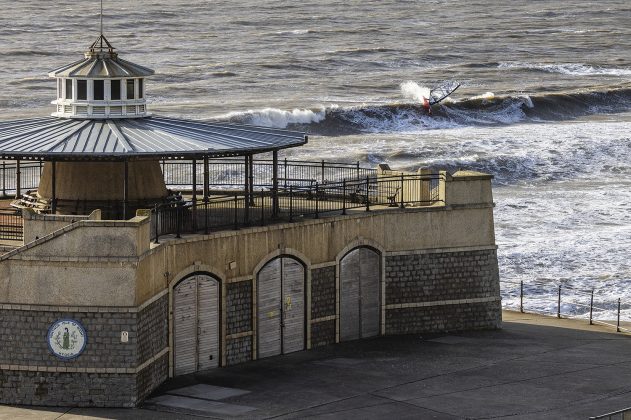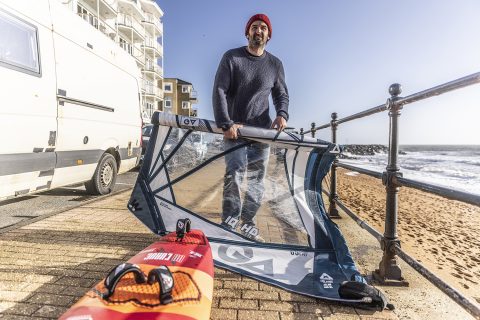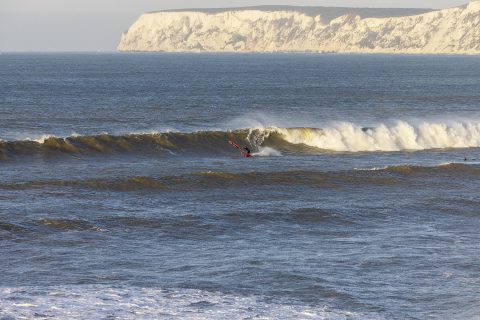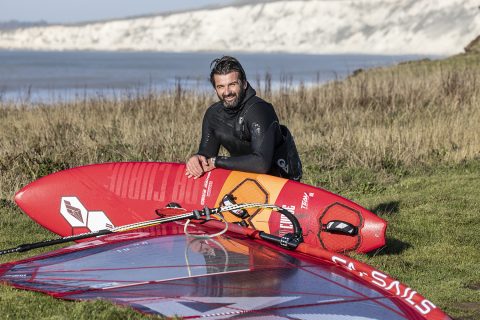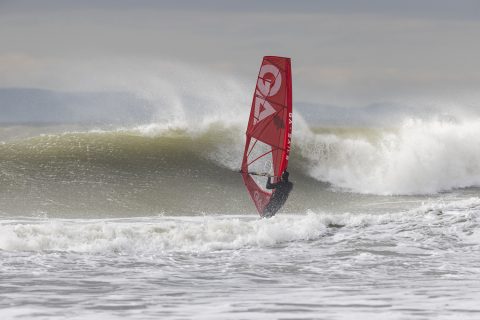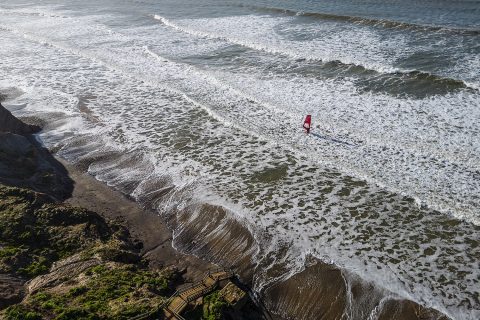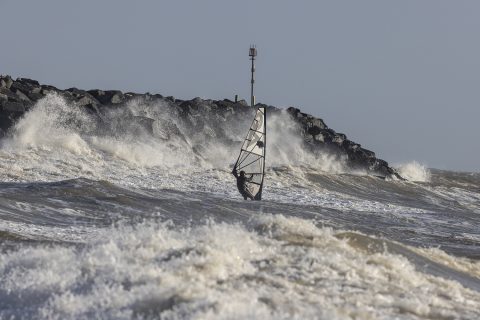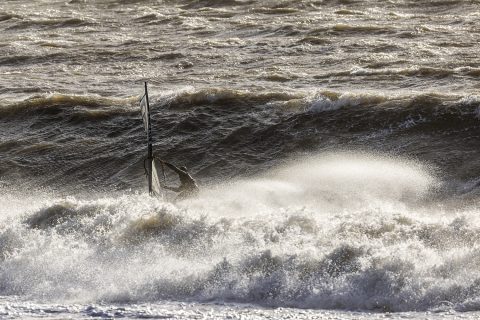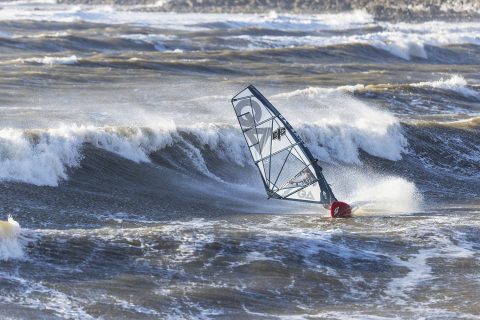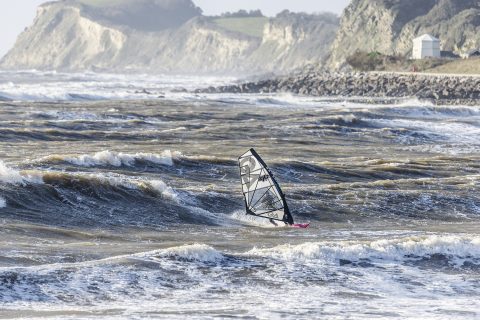ROSS WILLIAMS: ROSS SKILLS
In the first of a two-parter, Ross Williams, gives us the benefit of his extensive knowledge on wavesailing, starting with some tips on quivers, getting out and bottom turns.
Words: Ross Williams // Photos: John Carter
QUIVER
Since I stopped competing, my aim has been to use less equipment. I want to carry less in my van, store less at home, and travel with less if I go away. I have basically narrowed my quiver down to four sails and two boards. The biggest sail in my quiver is a 5.2 for light winds. After that I drop down to a 4.8, which is the traditional drop down size in mid-range wave sails, and my final sails are a 4.4 and a 4.0 for the small sizes. Those four sails can pretty much cover me for everything. I can hang onto a 4.0 in a lot of wind, and be very efficient on a 5.2 in light winds.
- Ross Williams
As for boards, I definitely think that going slightly bigger volume than your bodyweight is ideal as your ‘big’ wave board, so you can float with it when required. Then for my second board, I would go for something that is 3-5 litres less than my bodyweight as a strong wind board. I find that a good balance as a two-board quiver. I weigh around 85 kg, so I would take an 88 litre as my biggest board to float me and that also won’t be too small a board for a 5.2 sail. A 95 kg guy could for instance go with a bigger size sail like a 5.6 or 5.7 and then have a 98-100 litre board for lighter winds.
- Ross Williams
For my smaller board I go with an 80 or 82 litre. There are no fixed rules, but for me having the big board three to five litres more than my weight and the small board around the same amount below my weight works. I would say with those four sails and two board sizes, you would have a well-rounded quiver for ninety per cent of the days you wave sail. There will always be the odd day that you might need something smaller or bigger, but when you way up the pros and cons of your quiver size, this set of gear should serve you well.
- Ross Williams
CHECKING
I will definitely sit for a while and check the conditions, even if it is a spot that I sail regularly. No two days are exactly the same. It is worth checking what the tide is doing and what the wind and waves are forecast to do. Also look upwind and check out what is coming. You can often see dark clouds looming, which can spell a change in the weather. Chat to other sailors and find out what they are using and that way you don’t end up taking the wrong gear out and spoiling your session.
- Ross Heads out
GETTING OUT
When you are working your way out, if there is a huge wall of whitewater coming towards you, I would advise to gybe, come back in and then wait for the right moment to sail out between sets. Only the very top guys will try and climb over a logo or mast-high wall of whitewater and actually succeed. Nothing is worse than getting munched before your first wave and being in the impact zone with a load of broken gear. If you have a bit of patience, you can pick your moment and make it out the back without having to take any risks.
- Heading out
If you are going to go up and over whitewater, then I would always try to bear off just before and have my feet out of the straps, with my front foot behind the mast track. You kind of want to ‘ollie’ up to the whitewater. If you are not planing, you just need to try and get your nose up as much as you can. So I kind of bear off and flick my way up the whitewater. Then try and balance my way over the turbulence. There is a massive advantage if you can pull this off, but climbing over broken waves comes with risks attached. There could be an even bigger wave behind that one, and if you do make it over the first wave, you could be in a more dangerous place than if you had just gybed and waited for your moment.
- Finding a way out
WAVE SELECTION
I usually take one of the last waves in the set, depending on how I see the wave lining up out the back. Obviously this is where watching the conditions when you arrive at the beach pays off. If you check a few sets before you hit the water, you can ascertain which waves are the best in the set. Quite often the first wave is moving all the water off the reef and helps suck the water out, so the second or third set wave is cleaner. If you are a novice, ideally you don’t want to be talking the first wave in a set, just because if something goes wrong, then you are in the impact zone with a whole set of waves about to pound you. If it is not a sandy location, you could end up losing your gear and going on the rocks. If it is a place of consequence, then taking one of the last waves in the set can be the wise option.
- Ross in the pit
BOTTOM TURN
The bottom turn is going to set you up for your top turn, so you need to think ahead about how the wave is going to break further down the line. Where you bottom turn is where you want to generate your speed, so you can carry it through the top turn and make that cutback more dynamic. In a way, the bottom turn is the most important part of riding a wave. You might be sailing a location that is breaking in a similar place on every wave, so you can line up with a landmark on the beach, knowing that is the place where you want to bottom turn. Sometimes you want to wait for the wave to almost start breaking so you bottom turn around the first section. In that bottom turn, I am engaging the power in the sail and looking ahead to where I am going. Your head is initiating what the rest of your body does. You look to the bottom of the wave because that is where you are going to be, then when you are in your bottom turn, you look up to where you are going to hit the wave. Your body follows what your head is dictating. This is a fluid motion all the way down to your legs, and to your feet and the actual turning of the board. So lead with your head, and your shoulders, hips, knees and foot pressure should guide you through in a fluid motion. That should continue through your ride, so that your head is always one step ahead of the actual transition that you are doing.
- Ross bottom turn
Bottom turns are a bit like when you are gybing you need to slide your back hand further down the boom as you are engaging, so you can adjust your angle or tighten up a turn. That way it becomes easier to sheet in the power and engage the rail. Once you have pulled in the power, you are able to push harder on your feet, to tighten up the turn. If you want to tighten your turn and also engage power and speed, then sheeting in will increase the power in the sail, which allows you to rail the board over because it is going faster. That allows you to put more foot pressure on, because you are focusing all the power that comes from sheeting in the sail, through your body, through your legs, and out through the turn.
- Ross at his home spot, Ventnor on the Isle of Wight


